If landscapes are a sum of their parts: how do we measure them?

By Eleanor Milne
At last year’s Forest Day, it seemed that there was one word on everybody’s lips: ‘landscapes’. We heard it in conversations, in presentations, even the event itself was held under the theme of ‘Living Landscapes’, representing a new collaboration between Forest Day and Agriculture, Landscapes and Livelihoods Day. A collaboration which explores the relation between forests, farming and people; which recognizes that every landscape is a patch-work of different land covers; and that these land covers interact with and impact on each other. It is an idea which understands that if we are to simultaneously address climate change, save forests and feed people, a landscape approach at a landscape-scale is needed.
However, conducting landscape-scale measurements and modeling has proved particularly difficult in developing countries. Here, many landscapes are dominated by smallholder farmers who typically own 1-2 hectares at most, meaning that management practices, farming systems; crop and livestock types can vary widely from hectare to hectare, posing many problems for large-scale quantification. But yet it is these very smallholder farmers that have the most to gain from landscape-scale quantification. For them, being part of landscape-scale quantification could potentially open up access to carbon markets and other financing from development agencies looking to support carbon friendly farming. What’s more, these environments hold the most potential for agricultural mitigation.
To help overcome these issues, CCAFS has just released a new report, entitled Methods for the quantification of emissions at the landscape level for developing countries in smallholder contexts, which is a comprehensive guide for GHG assessors looking to do landscape-scale quantification in smallholder environments.
Not only does the report evaluate previous approaches to GHG quantification, but it also looks at which new resources are available for someone wanting to do this kind of assessment. The report identifies a selection of resources ranging from protocols for taking measurements in the field to online calculators which use information on land management practices.,The report provides both quick and detailed analyses of the specific contexts that each resource is best suited to. It does not strive to find a single ‘best’ solution, because what is ‘best’ will always be dependent on the context. Nor is it for a specific limited audience, it is an aid that can be used by anyone wishing to conduct GHG assessments; whether from a funding agency, a government agency, a NGO, academia or elsewhere.
Eleanor Milne has worked as an Environmental Scientist for the past 18 years and currently coordinates the modelling component of the GEF's Carbon Benefits Project. You can read more about CCAFS's work in pro-poor climate mitigation here or click here to read about CCAFS's work to improve quantification of agricultural GHG emissions in developing countries.This blog was edited by Lucy Holt.


